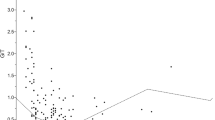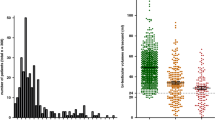Abstract
Objective
Management of cryptorchidism is typically recommended within the first 18 months of life to maximize fertility potential. However, there is a paucity of longitudinal postoperative data for Chinese infants. We aim to evaluate the Testicular function change when the procedure is done within the first year of life.
Method
We prospectively enrolled 51 children diagnosed with unilateral inguinal cryptorchidism into the surgical group between January 2021 and January 2022. Orchidopexy was carried out through a single transverse scrotal incision. Assessments of anti-Mullerian hormone (AMH), inhibin B (InhB), testosterone (T) levels, testicular volume and testicular atrophy index (TAI) were conducted at baseline, 6 months, and 1 year following surgery. Concurrently, clinical data from 42 healthy age-matched controls were collected during their routine physical examinations.
Results
At 6- and 12-months post-surgery, testicular volume increased significantly to 0.98 ± 0.12 mL and 1.01 ± 0.12ml. AMH levels also rose from 76.40 ± 15.77 ng/mL to 81.52 ± 15.32 ng/mL and 87.50 ± 15.36 ng/mL. However, these parameters are significantly lower than age-matched healthy controls (both P < 0.001). InhB levels significantly increased after surgery and even surpassed those of healthy controls after 6 months (both P < 0.001). The TAI was 16.7% and 8.6% at 6- and 12-months following surgery.
Conclusion
Although orchiopexy can improve testicular growth and function, the restoration of testicular function to the level of healthy peers might take longer. To expedite the recovery of testicular function and bring it in line with that of peers, we recommend addressing cryptorchidism at the earliest opportunity.

Similar content being viewed by others
Data availability
The raw data supporting the conclusions of this article will be made available by the authors, without undue reservation.
References
Ceccanti S, Migliara G, De Vito C, Cozzi DA (2022) Prevalence, management, and outcome of cryptorchidism associated with gastroschisis: a systematic review and meta-analysis. J Pediatr Surg 57(7):1414–1422
Fawzy F, Hussein A, Eid MM, El Kashash AM, Salem HK (2015) Cryptorchidism and Fertility. Clin Med Insights Reprod Health 22(9):39–43. https://doi.org/10.4137/CMRH.S25056. (PMID:26740750 PMCID:PMC4689328)
Jia H, Ma T, Jia S, Ouyang Y (2021) AKT3 and related molecules as potential biomarkers responsible for cryptorchidism and cryptorchidism-induced azoospermia. Transl Pediatr 10(7):1805–1817. https://doi.org/10.21037/tp-21-31
Christensen AK, Mason NR (1965) Comparative Ability of Seminiferous Tubules and Interstitial Tissue of Rat Testes to Synthesize Androgens from Progesterone-4-14c in Vitro. Endocrinology 76:646–656
Zirkin BR, Papadopoulos V (2018) Leydig cells: formation, function, and regulation. Biol Reprod 99(1):101–111. https://doi.org/10.1093/biolre/ioy059
Thorup J, Cortes D (2019) Surgical management of undescended testis - timetable and outcome: a debate. Sex Dev Genet Mol Biol Evol Endocrinol Embryol Pathol Sex Determ Differ 13(1):11–19
Kolon TF, Herndon CD, Baker LA, Baskin LS, Baxter CG, Cheng EY, Diaz M, Lee PA, Seashore CJ, Tasian GE, Barthold JS, Assocation AU (2014) Evaluation and treatment of cryptorchidism: AUA guideline. J Urol 192(2):337–345. https://doi.org/10.1016/j.juro.2014.05.005
Braga LH, Lorenzo AJ, Romao RLP (2017) Canadian Urological Association-Pediatric Urologists of Canada (CUA-PUC) guideline for the diagnosis, management, and followup of cryptorchidism. Can Urol Assoc J Journal de l’Association des Urologues du Canada 11(7):E251–E260. https://doi.org/10.5489/cuaj.4585
Radmayr C, Dogan HS, Hoebeke P, Kocvara R, Nijman R, Silay S, Stein R, Undre S, Tekgul S (2016) Management of undescended testes: European Association of Urology/European Society for Paediatric Urology Guidelines. J Pediatr Urol 12(6):335–343. https://doi.org/10.1016/j.jpurol.2016.07.014
Wang YJ, Chen L, Zhang QL, Lin Y, Cui X, Chen JC et al (2020) Transscrotal transverse incision for the treatment of middle and low cryptorchidism in children: experience from 796 cases. BMC Surg 20(1):51
Jan IA, Hassan M, Shalaan I, Alshehhi MA (2021) Single Median Raphe Scrotal incision Orchiopexy: a safe & feasible approach for fixation of Palpable Undescended testes. Pak J Med Sci 37(7):1930–1934
Feng S, Yang H, Li X, Yang J, Zhang J, Wang A et al (2016) Single scrotal incision orchiopexy versus the inguinal approach in children with palpable undescended testis: a systematic review and meta-analysis. Pediatr Surg Int 32(10):989–995
Annandale T (1879) Case in which a testicle congenitally displaced into the perinaeum was successfully transferred to the scrotum. BMJ 1(940):7
Canavese F, Mussa A, Manenti M et al (2009) Sperm count of young men surgically treated for cryptorchidism in the first and second year of life: fertility is better in children treated at a younger age. Eur J Pediatr Surg 19:388–391
Pettersson A, Richiardi L, Nordenskjold A et al (2007) Age at surgery for undescended testis and risk of testicular cancer. N Engl J Med 356:1835–1841
Zvizdic Z, Milisic E, Halimic A, Zvizdic D, Zubovic SV (2014) Testicular volume and testicular atrophy index as predictors of functionality of unilaterally cryptorchid testis. Med Arch 68(2):79–82
Yang M, Wen S, Lin T, Liu X, Zhang DY, Liu F et al (2022) Diagnosis, treatment, outcome, and reasons for delayed treatment of cryptorchidism with torsion in children: a 16-year retrospective study in a large pediatric medical center. Asian J Androl 24(4):386–389
Goulis DG, Tsametis C, Iliadou PK, Polychronou P, Kantartzi PD, Tarlatzis BC et al (2009) Serum inhibin B and anti-Mullerian hormone are not superior to follicle-stimulating hormone as predictors of the presence of sperm in testicular fine-needle aspiration in men with azoospermia. Fertil Steril 91(4):1279–1284
Cortes D, Clasen-Linde E, Hutson JM, Li R, Thorup J (2016) The Sertoli cell hormones inhibin-B and anti Mullerian hormone have different patterns of secretion in prepubertal cryptorchid boys. J Pediatr Surg 51(3):475–480
Weintraub A, Eldar-Geva T (2017) Anti-Mullerian Hormone (AMH) Determinations in the Pediatric and Adolescent Endocrine Practice. Pediatr Endocrinol Rev PER 14(4):364–370
Kollin C, Karpe B, Hesser U et al (2007) Surgical treatment of unilaterally undescended testes: testicular growth after randomi- zation to orchiopexy at age 9 months or 3 years. J Urol 178:1589–1593
Coughlin MT, Bellinger MF, Lee PA (1999) Age at unilateral orchiopexy: effect on hormone levels and sperm count in adult- hood. J Urol 162:986–988
Acknowledgements
The authors acknowledge the Provincial Health Special Subsidy Project of Fujian Provincial Finance Department ((2020)467). The knowledge obtained from this study is expected to have a crucial impact on refining the approach to cryptorchidism management and ultimately improving patient outcomes.
Author information
Authors and Affiliations
Contributions
WH, LY, and CM contributed to conception and design of the study. SS organized the database. ZQ and XC performed the statistical analysis. WH wrote the first draft of the manuscript. WH, LY, and CM wrote sections of the manuscript. All authors contributed to manuscript revision, read, and approved the submitted version. To Provincial health special subsidy project of Fujian Provincial Finance Department (20,202,616).
Corresponding author
Ethics declarations
Conflict of interest
No conflict of interest exists in the submission of this manuscript, and this manuscript is approved by all authors for publication. I would like to declare on behalf of my coauthors that the work described was original research that has not been published previously, and is not under consideration for publication elsewhere, in whole or in part. All the authors listed have approved the manuscript that is enclosed.
Additional information
Publisher's Note
Springer Nature remains neutral with regard to jurisdictional claims in published maps and institutional affiliations.
Rights and permissions
Springer Nature or its licensor (e.g. a society or other partner) holds exclusive rights to this article under a publishing agreement with the author(s) or other rightsholder(s); author self-archiving of the accepted manuscript version of this article is solely governed by the terms of such publishing agreement and applicable law.
About this article
Cite this article
huang, W., Xu, L., Chen, S. et al. Evaluating testicular function changes in unilateral cryptorchid chinese infants underwent orchidopexy in the first year of life. Int Urol Nephrol 56, 1537–1542 (2024). https://doi.org/10.1007/s11255-023-03896-4
Received:
Accepted:
Published:
Issue Date:
DOI: https://doi.org/10.1007/s11255-023-03896-4




